
|
|
(chronologically, by film title) Intro | Summary Chart | Silents-1949 | 1950 -1966 | 1967-1969 | 1970-1974 | 1975-1977 | 1978-1979 1980 | 1981 | 1982 | 1983-1984 | 1985-1986 | 1987-1989 1990-1991 | 1992-1994 | 1995 - 1 | 1995 - 2 | 1996-1997 | 1998 | 1999 | 2000 | 2001 - 1 | 2001 - 2 2002 - 1 | 2002 - 2 | 2002 - 3 | 2003 | 2004 | 2005 | 2006 | 2007-2011 | 2012-2014 | 2015-2017 | 2018-2019 | 2020-2021 |
|
| Film Title, Director, Studio, Budget Information, Description | |
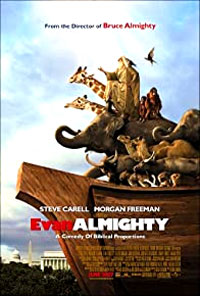
|
Evan Almighty (2007) Director: Tom Shadyac Studio/Distributor: Universal Pictures Budget: $175 million Domestic Gross: $100.5 million Worldwide Gross: $174.4 million Total Net Loss: $87 million Total Estimated Loss (Inflation-Adjusted): $114 million |
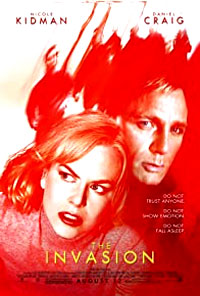
|
The Invasion (2007) Director: Oliver Hirschbiegel Studio/Distributor: Warner Bros. Budget: $80 million Domestic Gross: $15 million Worldwide Gross: $40.2 million Total Net Loss: $71 million Total Estimated Loss (Inflation-Adjusted): $93 million |
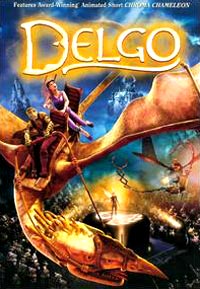
|
Delgo (2008) This non-Hollywood studio, computer-animated fantasy film was nine years in the making. In the near decade it took to reach screens, advancements in CGI had mostly outpaced this entry. The timing of its release (during a glut of Christmas holiday films) and its poor marketing also led to dismal box-office of around $700K. It remains at #1 for the worst "Very Wide" opening (2,000+ theatres) of all-time - in terms of attendance, it averaged about two individuals per screen. It was a spectacular, misconceived failure! The idea of a romance between animated characters Freddie Prinze, Jr. and Jennifer Love Hewitt had cooled considerably from when it was originally conceived. The dark and convoluted film, with odd-looking creatures and an overly-complex opening voice-over narration, seemed unappealing and tedious to children, and looked more like a video-game than anything else, with hints of The Dark Crystal (1982). The voices of the animated characters included Anne Bancroft (in her final film performance, as power-mad Sedessa - her death in 2005 was one of the film's many problems), and C-list actors including Freddie Prinze, Jr. (as Delgo), Jennifer Love Hewitt (as Kyla), and Val Kilmer (as Bogardus). The children's fantasy story was set in the magical world of Jhamora, that was divided by fear and on the brink of war. The two warring civilizations were the winged Nohrin who rode on dragons, and the earthbound, reptilian Lokni. The exiled conqueress queen Sedessa, conspiring with her treacherous ogre General Raius (Malcolm McDowell) threatened to conquer both races. Young Lokni adolescent-lizard Delgo, with forbidden love-interest Kyla - dragon-fly Princess of Nohrin, was heroically compelled to join with tough Nohrin general Bogardus to defeat the warring Sedessa, protect the world from destruction and achieve peace. |
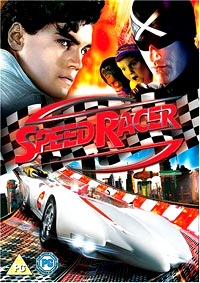
|
Speed Racer (2008) In the futuristic adventure race/chase fantasy live-action film enhanced with CGI, Emile Hirsch took the role of James "Speed" Racer, the youngest and most fearless racer in the World Racing League (WRL), with a custom-made Mach 5. The back story told of his deceased older brother Rex Racer (who died racing in the Casa Cristo Cross Country 5000 Rally with a tarnished reputation), and encouragement and support from his father Pops Racer (John Goodman), who designed his car, and his mother Mom Racer (Susan Sarandon). Speed Racer was presented with (and rejected) a lucrative sponsorship offer to drive for racing manufacturing giant Royalton Industries, led by maniacal owner E.P. Arnold Royalton (Roger Allam). He then learned that the Grand Prix races were being fixed by cheating, through support of multi-national sponsorships, and drivers were being manipulated to increase stock prices for Royalton. Angered by Speed Racer's refusal, Royalton told him that he would never win again and that he would destroy the family business. To redeem himself, Speed Racer engaged in the cross-country race called the Crucible that had previously killed his brother, garnering support from his longtime and loyal girlfriend Trixie (Christina Ricci) - a helicopter pilot, and his mysterious one-time rival - a masked and leather-suited driver named Racer X (Matthew Fox). He sought to rescue his family's business and the integrity of racing itself. In the film's plot twist, Rex hadn't died, but had assumed the disguise and identity of Racer X. It was unclear who the escapist film's target audience was designed to be for - for gamers or fanboys, but maybe not for kids? Surely, box-office suffered when the film was interpreted as being too childish (by male teens), and too frenetic and simplistic for adults, and racing films were never very popular. In any case, 135 minutes was too long. The summer's hyped-up film only took in $18.6 million in its opening weekend, and went down from there ($8.1 million in its second weekend). It was nominated for a Razzie Award in the category of Worst Prequel, Remake, Rip-Off or Sequel, losing to Indiana Jones and the Kingdom of the Crystal Skull (2008). The stylistic, garish, and gaudy film was filled with hyperkinetic candy-colors, and video game-style (CG) racing segments - an expensive experiment to make it look like it was taking place within a 3-D cartoonish world or comic strip. The dramatic action scenes basically fell flat, not realistic enough to promote tension. Family values were provided, as well as a bratty pet chimp named Chim Chim, and Speed Racer's fat and annoying beanie-headed brother Spritle Racer (Paulie Litt) to round out the pretentious, mindless proceedings. |
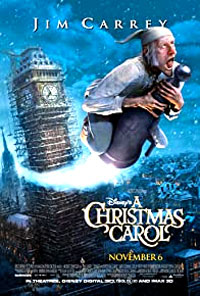
|
A Christmas Carol (2009) Director: Robert Zemeckis Studio/Distributor: Walt Disney Pictures Budget: $175-200 million Domestic Gross: $137.9 million Worldwide Gross: $325.3 million Total Net Loss: $50-100 million Total Estimated Loss (Inflation-Adjusted): $63-143 million |
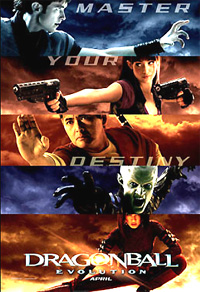
|
Dragonball Evolution (2009) This PG-friendly, martial-arts, fantasy-adventure action film was based upon Akira Toriyama's best-known Japanese manga and anime series known as "Dragonball." The live-action film was also inspired by the Japanese anime TV series adaptations: Dragon Ball (1986-1989) and Dragon Ball Z (1989-1996). After its release, the forgettable film was negatively-reviewed, and disowned by the original author Akira Toriyama. Screenwriter Ben Ramsey apologized for the film, and two of its stars Emmy Rossum and James Marsters hated the film and told fans to avoid seeing it. Plans for any future sequels were cancelled due to the film's paltry box-office response and lackluster enthusiasm. In the film's plot, the title referred to a group of seven magical orbs (or balls) that had been used to banish from Earth the evil, green-skinned warlord Lord Piccolo (James Marsters) and his monstrous minion Ōzaru the Great Ape. Piccolo had attempted to destroy Earth during a solar eclipse but was thwarted by monks who defeated and imprisoned him. The vengeful Piccolo was due back in 2,000 years and would undoubtedly seek to regain the Dragonballs and destroy Earth. This set into motion in the present a race against time (with another eclipse approaching) to hunt for and gather together all seven Dragonballs (marked with numbered stars from 1 to 7) that had been scattered everywhere. Their possessor would be granted one perfect wish. Piccolo's wish, once again, would be to destroy Earth. Young teen martial-arts warrior Son Goku (Justin Chatwin) was one of those who set out on a quest to gain all of the powerful and mystical Dragonballs, and defend the planet from alien forces. On his 18th birthday, Goku was given the 4th Dragonball by his wise grandfather Grandpa Gohan (Randall Duk Kim), his martial-arts trainer. But then evil Lord Piccolo murdered Gohan during his search for the Dragonballs, with his new ninja, shape-shifting henchwoman Mai (Eriko Tamura). Goku was advised to seek out his grandfather's trainer, Master Muten Roshi (Chow Yun-Fat) for help, while assisted by scientist and gadget expert Bulma (Emmy Rossum), and later by desert bandit-thief Yamcha (Joon Park). They located Roshi in Paozu City, and enlisted him in their further search for more Dragonballs, with the help of Goku's classmate and love interest Chi-Chi (Jamie Chung). In the film's conclusion, the group was able to battle and defeat Piccolo (who revealed himself as Ōzaru the Great Ape). Afterwards however, they realized they needed to commence their search once more, since the Dragonballs were again scattered. |
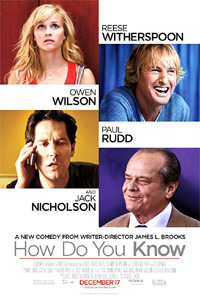
|
How Do You Know (2010) Director/writer James L. Brooks' romantic comedy appeared to have all the right components: an ensemble quartet of strong actors involved in a complex love triangle, and the theme of finding oneself during an identity crisis. However, the overlong, sometimes glib, unfunny and contrived dramatic production was plagued by various systemic problems brought on by Sony: high salaries for the A-list veteran stars and director, a lengthy film shoot and post-production, the reshooting of the film's beginning and ending, and a film release during the crowded end-of-year time frame. On its opening weekend, it was ranked # 8 (at only $7.5 million), far behind the openings of Tron: Legacy (2010) (at $44 million) and Yogi Bear (2010) (at $16.4 million). It also struggled the same weekend against three films in their second week: The Chronicles of Narnia: The Voyage of the Dawn Treader (2010) (at $12.4 million), The Fighter (2010) (at $12.1 million), and The Tourist (2010) (at $8.5 million). And it even lost out to a film in its third week: Black Swan (2010) (at $8.4 million). The mostly unlikable, overly-busy and sluggish sit-com story followed the travails of star Team USA softball player, cute and adorable but bland Lisa Jorgenson (Reese Witherspoon) after she was cut from her team, and was concerned about her advancing age of 30. Devastated and single, she moved in with Matty Reynolds (Owen Wilson), a professional major league baseball pitcher and engaged in a casual fling with the womanizing, narcissistic athlete. Meanwhile, her acquaintance George Madison (Paul Rudd), a straight-laced and honest corporate executive, had been fired from his tycoonish and creepy father Charles Madison's (Jack Nicholson) company after it was found guilty by federal officials of financial malfeasance (stock-fraud). Although George was indicted and willing to take the blame, his wheeling-dealing father ultimately confessed that he was the guilty one. George was emotionally supported by his loyal, pregnant, and honest secretary Annie (Kathryn Hahn). The entanglements of the love triangle between Lisa, Charles, and Matty comprised the bulk of the remainder of the film. |
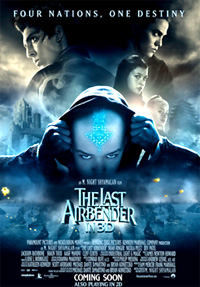
|
The Last Airbender (2010) Writer/director M. Night Shyamalan's live-action, action-adventure fantasy film was produced by Nickelodeon Movies and distributed by Paramount, due to its origins as Nickelodeon's first season in 2005 of its beloved animated TV series Avatar: The Last Airbender. The unpopular film had a rough start when critically-bashed by many reviewers as one of the worst movies ever made. It was produced on a $150 million budget, and grossed only $131 million (domestic), but recouped some of its losses through its strong showing of $319 million (worldwide). Regarded as possibly the worst and most boring Shyamalan film ever made (even when compared to his previous films Lady in the Water (2006) and The Happening (2008)), the failed blockbuster movie was severely criticized for its "incomprehensible plotting, horrible acting, and detached joyless direction." Due to its poor showing and almost-universal very low ratings, a planned trilogy of films was cancelled. The film's controversial casting was questioned, when several white actors played characters who were Asian in the original TV series. There were several calls to boycott the film as a result. The film's story was based on the TV show, following the adventures of the young title character Aang (Noah Ringer) - an Avatar master and successor to a long line of Avatars. He was the final Airbender, living in an Asiatic-like world with four different nations. With his telekinetic powers (a variant of Chinese martial arts known as "bending"), as an Avatar, he was able to master, manipulate (or bend) not just one but all four elements -- fire, water, earth, and air. There were various associated masters for each nation that had mastered their elements: the Waterbenders, Earthbenders, Firebenders, and Airbenders. As the last surviving Avatar and Airbender, Aang had been locked away and frozen in an iceberg for a century, with his flying pet bison Appa. All the other Airbenders, in the meantime, had been eliminated by Fire Lord Ozai (Cliff Curtis), thereby unbalancing the world. The Fire Lord's greedy mission was global domination, to be accomplished by his hot-tempered, Fire Nation Commander Admiral Zhao (Aasif Mandvi) - to enslave, conquer and terrorize in particular two other nations: the Water Tribes and the Earth Kingdom. After being freed and helped to escape by two teens in the Southern Water tribe: 14 year-old Katara (Nicola Peltz) (the last Waterbender) and her older 15 year-old warrior-brother Sokka (Jackson Rathbone), Aang's main objective - with his powerful abilities, was to halt the Fire Nation's enslavement, maintain harmony, and unite the people of the world's four nations. In a sub-plot, the Fire Lord's banished 16 year-old son Prince Zuko (Dev Patel), the former heir to the throne, was seeking his father's praise and honor by capturing Aang, and found himself competing with Zhao - who had the same idea. |
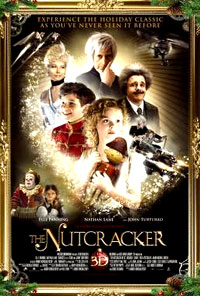
|
The Nutcracker in 3D (2010) (aka
The Nutcracker: The Untold Story) Director: Andrei Konchalovsky Studio/Distributor: Vnesheconombank Budget: $100-160 million Domestic Gross: $195,459 Worldwide Gross: $20.5 million Total Net Loss: $82 million Total Estimated Loss (Inflation-Adjusted): $102 million |

|
The Wolfman (2010) Director: Joe Johnston Studio/Distributor: Universal Pictures Budget: $150 million Domestic Gross: $62 million Worldwide Gross: $139.8 million Total Net Loss: $76 million Total Estimated Loss (Inflation-Adjusted): $94 million |
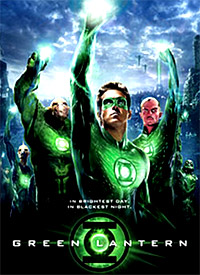
|
Green Lantern (2011) This much-anticipated, live-action super-hero film about a DC Comics character was an underperforming box-office flop, since its total revenue couldn't make up for its exorbitant cost. Critics bashed the overly ambitious, 3-D film very negatively, calling it overproduced, unimaginative, lifeless, and noisy with less than stellar, cheesy special effects. They also mentioned that the superhero character was miscast (with Ryan Reynolds) and unfamiliar to comic book fans. Four screenwriters prepared the slightly incoherent script, that included inconsistent pacing, four different muddled plots, and evidence of their clashing styles. Plans for a sequel - which were quite evident in the way the script played out - were dampened when the revenue results were considered disappointing. The cosmic, super-powered, emerald-suited peace-keeping hero was human test pilot Hal Jordan (Ryan Reynolds), who was called upon to battle the powerful and fearful evil force known as the Parallax (voice of Clancy Brown) after one of the purple intergalactic warriors (Abin Sur (Temuera Morrison)) in the police force, known as the Green Lantern Corps, experienced a deadly crash after an encounter with the force. [Parallax was an entity that ruled via fear (signified by yellow).] A magic, emerald-colored, empowering ring (powered by a lantern) chose Hal as Abin Sur's successor. He would be the first Earthman inducted into the Corps, to continue the fight after he endured training on the home planet of Oa, although he was viewed skeptically by the League's leader Thaal Sinestro (Mark Strong). Jordan was instructed and mentored as a new recruit by drill sergeant Kilowog (voice of Michael Clarke Duncan) and bird-beaked Tomar-Re (voice of Geoffrey Rush), but left when thought to be unfit and fearful by Sinestro. Parallel action was also occurring on Earth, where nerdy scientist Dr. Hector Hammond (Peter Sarsgaard) was infected by the evil yellow energy from Parallax (causing his brain to expand), while performing an autopsy on Abin Sur's body at a secret government facility. The now-insane, menacing scientist with telekinetic and telepathic powers threatened Hal's love-interest girlfriend and fellow test pilot Carol Ferris (Blake Lively). Meanwhile, the malevolent Parallax's ultimate goal was to consume all life on Earth, and wipe out all of humanity, to energize itself to conquer Oa. In the conclusion, Jordan bravely lured Parallax away from Earth and toward the Sun, using the Sun's gravity to pull and disintegrate the entity. A sequel was set up, when Sinestro took on the characteristics of Parallax after placing a yellow-energized ring on his finger. |
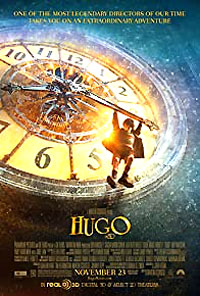
|
Hugo (2011) Director: Martin Scorsese Studio/Distributor: Paramount Pictures Budget: $150-170 million Domestic Gross: $73.9 million Worldwide Gross: $185.8 million Total Net Loss: $91 million Total Estimated Loss (Inflation-Adjusted): $110 million |
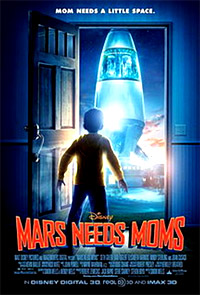
|
Mars Needs Moms (2011) Reviews were quite bland for Disney's big-budgeted, motion-capture, animated science-fiction film. The market audience for a laboring, dark 3-D film about a mission to save one's Mom who had been snatched into space was unclear, and it was filled with mostly uninteresting characters, a simplistic plot, and strangely illogical ideas about body image and sex roles. Unadjusted for inflation, it currently reigns as one of the biggest box-office bombs in film history, with a total net loss of approx. $144 million. It was the last film of Robert Zemeckis' ImageMovers Digital studio. As with other motion-capture films, it was criticized for its mannequin-like characters with soul-less eyes, unreal movements, and waxy complexions. Due to the film's commercial failure, Disney was forced to cancel its other motion-capture venture, a remake of Yellow Submarine (1968). The adventure story, based upon the children's novel by Pulitzer Prize-winning cartoonist Berkeley Breathed, told about whiny, complaining 9 year-old Milo (Seth Green, with voice by Seth Dusky) who was rude to his mother (Joan Cusack), and then had to rescue her after her Martian kidnapping during her sleep. She had been abducted by the flat-faced aliens to harvest her disciplining maternal instincts with a solar-powered device, in order to program and train the nanny-robots that cared for their young hatchlings (who grew out of the ground like vegetables) - and then she would be disposed of. Milo was forced to take a treacherous and perilous journey into an extraordinarily foreign world as a stowaway in the alien spacecraft bound for Mars, in order to make a daring rescue and bring her back. On the red Mars planet, Milo befriended lonely, techno-geeky, subterranean-dwelling earthling Gribble (Dan Fogler), living in a garbage dump. Another unlikely ally was rebellious, colorful graffiti-artist Martian Ki (Elisabeth Harnois), who had been educated in Earthly life by a 60's hippie-related TV sitcom, and frequently spouted flower-power slogans. The two agreed to help him locate his missing mother and confront the tyrannical and militaristic head queen alien Supervisor (voice of Mindy Sterling). |